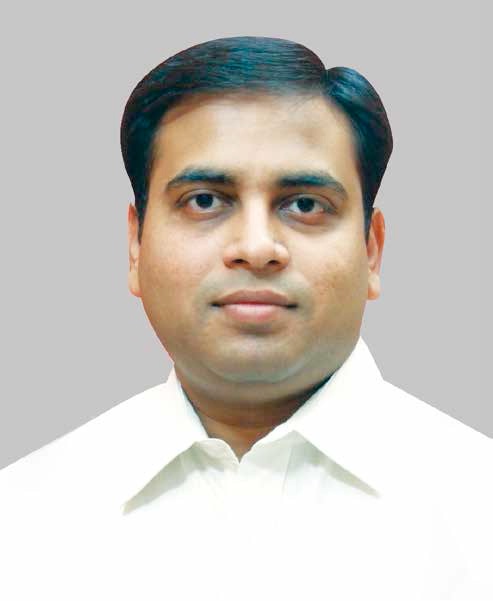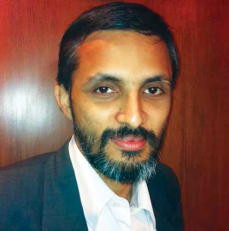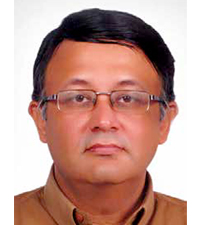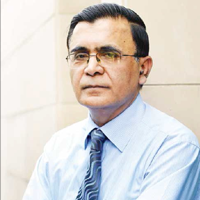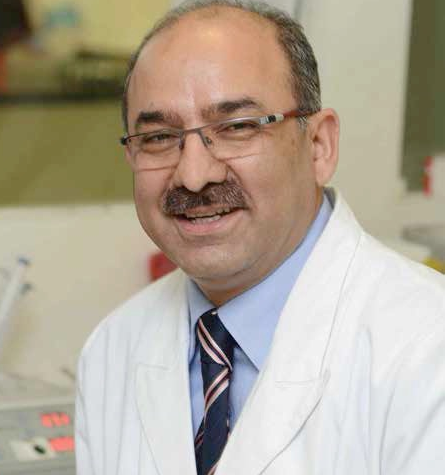
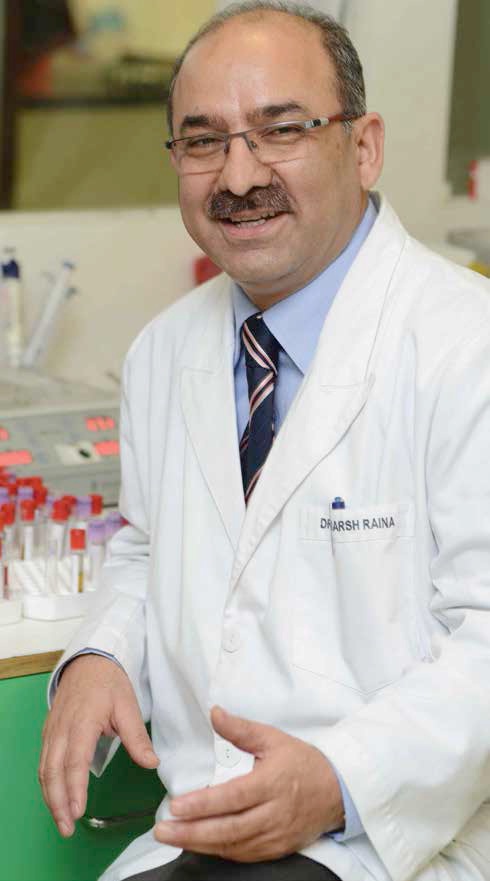 Dr Vimarsh Raina, Director- Pathology, Laboratory & Transfusion Medicine, ensures the quality blood bank at Medanta The Medicity. In conversation with Shahid Akhter, ENN, he discusses the role of technology and the need for safety in channelizing the blood components
Dr Vimarsh Raina, Director- Pathology, Laboratory & Transfusion Medicine, ensures the quality blood bank at Medanta The Medicity. In conversation with Shahid Akhter, ENN, he discusses the role of technology and the need for safety in channelizing the blood components
Please tell us about the evolution of transfusion services in the Indian perspective?

Blood banks are no longer dispensing windows for blood products created out of blood donated by healthy altruistic blood donors. A modern blood bank or transfusion service is an organized and yet complicated institution which not only converts voluntarily donated blood into blood components but is also having a very proactive role in therapeutics for critical illnesses like Myasthenia Gravis, Guillain Barre syndrome, Leukemia etc. A modern blood bank has a pivotal role in assisting the treatment of patients in multispecialty and super- specialty hospitals. No hospital handling critical and terminally ill patients can function without the support and services of an efficient transfusion service.

It goes without saying that a modernized blood bank would have 100 percent blood component therapy, provide leuco-reduced blood products, have the safest possible chemiluminscense and NAT (Nucleic Acid Test)based technologies to ensure blood safety and also be able to provide blood support in situations where the patients are sensitized and hence may not be able to tolerate even the same blood group transfusions.

Blood banking in India is different from the US. What learning can we put to use from the West?

In US, there is 100% voluntary blood donation at blood centers located in each city. After complete testing and component separation the blood is shipped to different hospitals based on requirement and from there, it is issued to patients.
In India, there is a lot of impetus given to promote voluntary blood donations by various organizations, but still most of the blood supply comes from hospital-based transfusion medicine center, in terms of replacement donations, which is usually done by friends and relatives of patients.
While some of the blood services in India may not be ideal, institutions like Medanta are proud to offer services and technologies which are at par with the best in the world.
India has an annual demand of about 10 million units and a significant part of it comes from replacement (one time blood donors). The trend and public participation in enhancing voluntary, regular, repeated blood donations is very heartening, especially from the educated younger people, whom we see many times taking off from their busy lives to fulfill their social obligations like blood donation.
Blood grouping test is confined to routine ABO and RhD typing. What about others that are left out? Doesnt this lead to complications?
A good transfusion service is not confined to blood grouping and transfusion of same group compatible transfusions. A well established transfusion service would test each and every potential patient who may need transfusion support for antibodies by a group and screen approach.
This ensures that not only wouldwe be able to provide blood efficiently and quickly at the time of an emergency but would also be able to pick up the difficult cases in advance and work them up for antibodies. Such patients would otherwise land up in extremely difficult and life threatening situations if the blood service is not able to provide compatible blood during an emergency.
Technological marvels and miracles are routine in healthcare? Have we made significant breakthroughs in Blood banking?
In the last decade transfusion services has made more progress than any other branch of medicine. Due to the technological innovations in transfusion services we are able to perform solid organ transplants, such as kidney or liver transplants, between individuals from different blood groups.
This is of great relevance to a nation like India where every year we have more than two lakh kidney failure patients needing a renal transplant but do not have access to a cadaveric donor or a family member who has the same blood group. In these situations a well equipped and experienced Transfusion Medicine Specialist can produce wonders by removing donor specific antibodies in the patient by doing plasma exchange prior to transplant.
Some life threatening illnesses like Thrombotic Thrombocytopenic Purpura ( TTP ) which had a mortality of above 90 percent within with a week to ten days of diagnosis have a fantastic outcome today.
Almost all patients diagnosed as TTP and who are treated by the transfusion medicine specialist with procedures such as Total Plasma Exchange (TPE) have a dramatic improvement and it is very gratifying to see the excellent outcome when you see a near dead patient walk out of your department hale and hearty within a week of the diagnosis.
Providing the safest possible blood components is our main concern and duty. We add an extra layer of safety and security in blood testing. NAT (Nucleic Acid Testing), for instance, is used to ensure safety of blood components.
What strides have we made in stem cell harvesting, preservation and infusion?
When we look at initial days, bone marrow was the only source for stem cell transplant. Today with Apheresis machines which are programmed for Peripheral Blood Stem Cell (PBSC) harvest, it has become relatively easy and less cumbersome doing a stem cell harvest followed by transplant.
Compared to bone marrow harvest, PBSC harvest is easy to do, much more safe for the donor, we can harvest precise dose required for the transplant and also post harvest complications are bare minimum and comparable to a simple platelet harvest.
These days the same PBSCs can be cryo-preserved for later use and with improved processing and storage techniques the patient outcomes have also improved.
Stem cell infusion is given under very strict and personalized medical supervision. The patients who receive these infusion are under immune suppression and hence admitted in specialized rooms with HEPA filters and trained personal, round the clock. Utmost care is taken to keep the surroundings clean and sterile which has direct effect on the patient outcome.
What is the USP of the transfusion centre at Medanta? What sets it apart from others?
The Transfusion Medicine Department at Medanta is unique in various aspects. We have a large team of highly qualified, dedicated and competent doctors who are available round the clock( 24 x7 x 365), are able to provide comprehensive services including
Blood component therapy and leuco- depleted products with log 4 reduction, which drastically reduces transfusion reactions in patients and prevents any graft versus host diseases (GVHD) and also to some extent prevents transmission of infections such as CMV.
Providing the safest possible blood to patients by doing 100% NAT testing which markedly reduces Transfusion Transmitted Infections (TTI).
Antibody screening for patients and providing corresponding antigen negative blood reducing incidence of hemolytic transfusion reactions.
Therapeutic plasma exchange for various conditions including for ABO incompatible liver and renal transplant patients.
Dedicated stem cell harvest and infusion team with inclusion of specialists from oncology, transfusion medicine and hematology.
What role does ICT play in the management of blood bank?
ICT plays an important role in blood bank as it helps in improving efficiency levels and reducing chances of errors. Each donor is registered in HIS (Hospital Information System) at the time of donation and all the reports including blood group and infectious markers are updated. Once a donor is found to be reactive for any of the markers (HIV, Hepatitis B, Hepatitis C, Malaria and/or Syphilis), the HIS system will automatically block the same blood unit from getting issued.
All the patient requests for blood are made through HIS and blood units are also issued through HIS. This helps in avoiding misuse of blood and a track can be kept for each and every patient.
What are the specialized programs in transfusion medicine at Medanta?
Medanta is running Post graduate programmed in transfusion medicine popularly known as DNB (Diplomate National Board). Medanta is one of the few centers in the country to offer this course. Besides the department hosts regular seminars and courses for doctors across Asia for enhancing their skill sets.
How do you visualize the future of blood banks?
I can see a paradigm shift in the blood banking. In all probability, in the near future blood (red blood cells) would no longer be coming from voluntary blood donors but would be a pharmaceutical product coming from dispensing pharmacies rather than the blood banks.
Major advancements in nano technology and molecular medicine are expected to revolutionize organ transplant both solid organ as well as bone marrow transplant and improve patient outcome. Blood banks would no longer be seen as just dispensing windows for blood products but would be playing a pivotal role in ensuring delivery of novel solutions such as dendritic cell therapies.
The facilities and professionals in Transfusion Medicine would be playing greater role in health care than they are presently delivering, moving from support specialty to proactive participants in patient care.
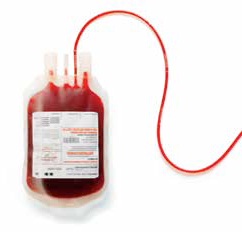 Specialised Programs
Specialised Programs
>> Therapeutic Plasmapheresis
>> Therapeutic Leukacytapheresis
>> Therapeutic Throbocytapheresis
>> Therapeutic Red Cell Exchange
>> Stem Cell Harvest
Be a part of Elets Collaborative Initiatives. Join Us for Upcoming Events and explore business opportunities. Like us on Facebook , connect with us on LinkedIn and follow us on Twitter , Instagram.
"Exciting news! Elets technomedia is now on WhatsApp Channels Subscribe today by clicking the link and stay updated with the latest insights!" Click here!









